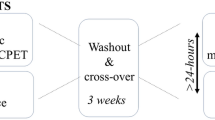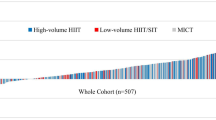Abstract
Purpose
The study aimed to identify single nucleotide polymorphisms (SNPs) that significantly influenced the level of improvement of two kinds of training responses, including maximal O2 uptake (VʹO2max) and knee peak torque of healthy adults participating in the high intensity training (HIT) program. The study also aimed to use these SNPs to develop prediction models for individual training responses.
Methods
79 Healthy volunteers participated in the HIT program. A genome-wide association study, based on 2,391,739 SNPs, was performed to identify SNPs that were significantly associated with gains in VʹO2max and knee peak torque, following 9 weeks of the HIT program. To predict two training responses, two independent SNPs sets were determined using linear regression and iterative binary logistic regression analysis. False discovery rate analysis and permutation tests were performed to avoid false-positive findings.
Results
To predict gains in VʹO2max, 7 SNPs were identified. These SNPs accounted for 26.0 % of the variance in the increment of VʹO2max, and discriminated the subjects into three subgroups, non-responders, medium responders, and high responders, with prediction accuracy of 86.1 %. For the knee peak torque, 6 SNPs were identified, and accounted for 27.5 % of the variance in the increment of knee peak torque. The prediction accuracy discriminating the subjects into the three subgroups was estimated as 77.2 %.
Conclusions
Novel SNPs found in this study could explain, and predict inter-individual variability in gains of VʹO2max, and knee peak torque. Furthermore, with these genetic markers, a methodology suggested in this study provides a sound approach for the personalized training program.




Similar content being viewed by others
Abbreviations
- AIC:
-
Akaike information criterion
- BMI:
-
Body mass index
- CIs:
-
Confidence intervals
- DAVID:
-
The database for annotation, visualization and integrated discovery
- DBP:
-
Diastolic blood pressure
- DNA:
-
Deoxyribonucleic acid
- ECG:
-
Electrocardiogram
- FDR:
-
False discovery rate
- GO:
-
Gene ontology
- GPS:
-
Genetic predisposition scores
- GWAS:
-
Genome-wide association study
- HDL:
-
High density lipoprotein
- HERITAGE:
-
Health risk factors, exercise training and genetics
- HIT:
-
High intensity training
- HOMA:
-
Homeostatic model assessment
- HR:
-
Heart rate
- HWE:
-
Hardy–Weinberg equilibrium
- LOOCV:
-
Leave-one-out cross-validation
- MAF:
-
Minor allele frequency
- QTL:
-
Quantitative trait locus
- RNA:
-
Ribonucleic acid
- SBP:
-
Systolic blood pressure
- SD:
-
Standard deviation
- SNP:
-
Single nucleotide polymorphism
- VʹCO2 :
-
Carbon dioxide output
- VʹO2 :
-
Oxygen uptake
- VʹO2max:
-
Maximal O2 uptake
References
Ahmetov I, Kulemin N, Popov D, Naumov V, Akimov E, Bravy Y, Egorova E, Galeeva A, Generozov E, Kostryukova E, Larin A, Lj M, Ospanova E, Pavlenko A, Starnes L, Żmijewski P, Alexeev D, Vinogradova O, Govorun V (2015) Genome-wide association study identifies three novel genetic markers associated with elite endurance performance. Biol Sport 32:3–9
Akhmetov II, Popov DV, Astratenkova IV, Druzhevskaia AM, Missina SS, Vinogradova OL, Rogozkin VA (2008) The use of molecular genetic methods for prognosis of aerobic and anaerobic performance in athletes. Hum Physiol 34:338–342
Barker RJ, Schofield MR (2008) Classifying individuals as physiological responders using hierarchical modeling. J Appl Physiol 105:555–560
Bouchard C, Rankinen T, Timmons JA (2011a) Genomics and genetics in the biology of adaptation to exercise. Comp Physiol 1:1603–1648
Bouchard C, Sarzynski MA, Rice TK, Kraus WE, Church TS, Sung YJ, Rao DC, Rankinen T (2011b) Genomic predictors of the maximal O2 uptake response to standardized exercise training programs. J Appl Physiol 110:1160–1170
Burgomaster KA, Howarth KR, Phillips SM, Rakobowchuk M, Macdonald MJ, McGee SL, Gibala MJ (2008) Similar metabolic adaptations during exercise after low volume sprint interval and traditional endurance training in humans. J Physiol 586:151–160
Chmelo EA, Crotts CI, Newman JC, Brinkley TE, Lyles MF, Leng X, Marsh AP, Nicklas BJ (2015) Heterogeneity of physical function responses to exercise training in older adults. J Am Geriatr Soc 63:462–469
Ghosh S, Vivar JC, Sarzynski MA, Sung YJ, Timmons JA, Bouchard C, Rankinen T (2013) Integrative pathway analysis of a genome-wide association study of VO2max response to exercise training. J Appl Physiol 115:1343–1359
Gibala MJ, Little JP, van Essen M, Wilkin GP, Burgomaster KA, Safdar A, Raha S, Tarnopolsky MA (2006) Short-term sprint interval versus traditional endurance training: similar initial adaptations in human skeletal muscle and exercise performance. J Physiol 575:901–911
Hamrick MW (2012) The skeletal muscle secretome: an emerging player in muscle-bone crosstalk. Bonekey Rep 1:60
Huang DW, Sherman BT, Lempicki RA (2009a) Systematic and integrative analysis of large gene lists using DAVID bioinformatics resources. Nat Protoc 4:44–57
Huang DW, Sherman BT, Lempicki RA (2009b) Bioinformatics enrichment tools: paths toward the comprehensive functional analysis of large gene lists. Nucl Acids Res 37:1–13
Huuskonen A, Tanskanen M, Lappalainen J, Oksala N, Kyröläinen H, Atalay M (2009) A common variation in the promoter region of interleukin-6 gene shows association with exercise performance. J Sports Sci Med 8:271–277
Ismail H, McFarlane JR, Nojoumian AH, Dieberg G, Smart NA (2013) Clinical outcomes and cardiovascular responses to different exercise training intensities in patients with heart failure: a systematic review and meta-analysis. JACC Heart Fail 1:514–522
Jørgensen LH, Petersson SJ, Sellathurai J, Andersen DC, Thayssen S, Sant DJ, Jensen CH, Schrøder HD (2009) Secreted protein acidic and rich in cysteine (SPARC) in human skeletal muscle. J Histochem Cytochem 57:29–39
Kelly SA, Nehrenberg DL, Hua K, Garland T Jr, Pomp D (2014) Quantitative genomics of voluntary exercise in mice: transcriptional analysis and mapping of expression QTL in muscle. Physiol Genomics 46:593–601
Norheim F, Raastad T, Thiede B, Rustan AC, Drevon CA, Haugen F (2011) Proteomic identification of secreted proteins from human skeletal muscle cells and expression in response to strength training. Am J Physiol Endocrinol Metab 301:E1013–E1021
Rankinen T, Argyropoulos G, Rice T, Rao DC, Bouchard C (2010) CREB1 is a strong genetic predictor of the variation in exercise heart rate response to regular exercise: the HERITAGE Family Study. Circ Cardiovasc Genet 3:294–299
Rankinen T, Sung YJ, Sarzynski MA, Rice TK, Rao DC, Bouchard C (2012) Heritability of submaximal exercise heart rate response to exercise training is accounted for by nine SNPs. J Appl Physiol 112:892–897
Rice TK, Sarzynski MA, Sung YJ, Argyropoulos G, Stütz AM, Teran-Garcia M, Rao DC, Bouchard C, Rankinen T (2012) Fine mapping of a QTL on chromosome 13 for submaximal exercise capacity training response: the HERITAGE Family Study. Eur J Appl Physiol 112:2969–2978
Thomaes T, Thomis M, Onkelinx S, Goetschalckx K, Fagard R, Lambrechts D, Vanhees L (2013) Genetic predisposition scores associate with muscular strength, size, and trainability. Med Sci Sports Exerc 45:1451–1459
Thompson PD, Moyna N, Seip R, Price T, Clarkson P, Angelopoulos T, Gordon P, Pescatello L, Visich P, Zoeller R, Devaney JM, Gordish H, Bilbie S, Hoffman EP (2004) Functional polymorphisms associated with human muscle size and strength. Med Sci Sports Exerc 36:1132–1139
Timmons JA, Knudsen S, Rankinen T, Koch LG, Sarzynski M, Jensen T, Keller P, Scheele C, Vollaard NB, Nielsen S, Akerström T, MacDougald OA, Jansson E, Greenhaff PL, Tarnopolsky MA, van Loon LJ, Pedersen BK, Sundberg CJ, Wahlestedt C, Britton SL, Bouchard C (2010a) Using molecular classification to predict gains in maximal aerobic capacity following endurance exercise training in humans. J Appl Physiol 108:1487–1496
Timmons JA, Knudsen S, Rankinen T, Sundberg CJ, Bouchard C (2010b) Predictive Biomarkers. International Patent WO 2010/028256 A2, 11 March 2010
Trilk JL, Singhal A, Bigelman KA, Cureton KJ (2011) Effect of sprint interval training on circulatory function during exercise in sedentary, overweight/obese women. Eur J Appl Physiol 111:1591–1597
Zarebska A, Jastrzebski Z, Kaczmarczyk M, Ficek K, Maciejewska-Karlowska A, Sawczuk M, Leońska-Duniec A, Krol P, Cieszczyk P, Zmijewski P, Eynon N (2014) THE GSTP1 c.313A > G polymorphism modulates the cardiorespiratory response to aerobic training. Biol Sport 31:261–266
Acknowledgments
This research was financially supported by DAEWOONG Pharmaceutical Co. LTD., and designed by the Department of Clinical Pharmacology and Therapeutics, Kyung Hee University Hospital, and the Bio-Age Medical Research Institute, Bio-Age Inc. All the data were analyzed and interpreted by all the authors.
Author information
Authors and Affiliations
Corresponding author
Additional information
Communicated by David C. Poole.
ClinicalTrials.gov identifier: NCT02241850.
Electronic supplementary material
Below is the link to the electronic supplementary material.
Rights and permissions
About this article
Cite this article
Yoo, J., Kim, BH., Kim, SH. et al. Genetic polymorphisms to predict gains in maximal O2 uptake and knee peak torque after a high intensity training program in humans. Eur J Appl Physiol 116, 947–957 (2016). https://doi.org/10.1007/s00421-016-3353-7
Received:
Accepted:
Published:
Issue Date:
DOI: https://doi.org/10.1007/s00421-016-3353-7




